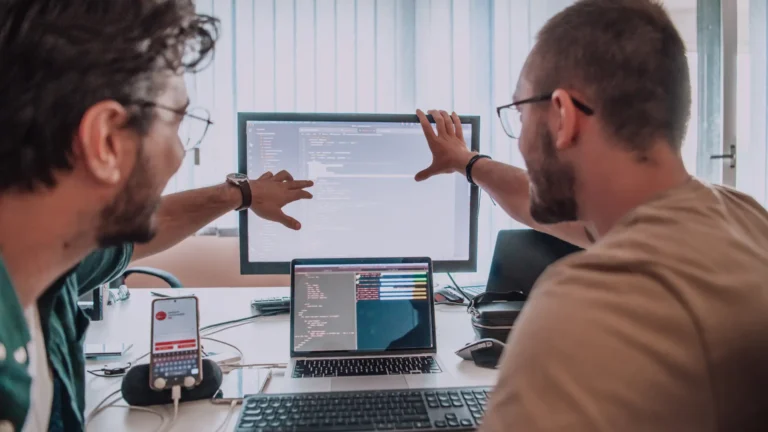- Made In INDIA

Businesses are constantly striving to outdo each other in delivering exceptional customer experiences. As technology evolves at an unprecedented pace, consumer expectations are reaching new heights. Today’s consumers demand solutions that are not just functional, but also personalized, innovative, and tailored to their unique needs. In this relentless race, companies that fail to adapt risk falling behind, while those that embrace the power of cutting-edge technologies and personalization stand to gain a significant competitive advantage. This is particularly true in the computer solutions industry, where personalization and innovation have become the twin pillars of customer satisfaction. This article explores how businesses in this industry can leverage these two elements to redefine the customer experience and establish themselves as industry leaders.
The computer solutions industry, in particular, has emerged as a battleground where personalization and innovation are the keys to unlocking unparalleled customer satisfaction. From powerful workstations to sleek laptops and intuitive software, the companies that can anticipate and meet the diverse requirements of their clients are poised to redefine the customer experience and cement their position as industry leaders.
One-size-fits-all approaches are rapidly becoming obsolete, personalization has emerged as the new frontier of customer engagement. Consumers today crave tailored experiences that speak directly to their unique preferences, workflows, and aspirations. They expect solutions that seamlessly integrate into their existing ecosystems, streamlining processes and enhancing productivity.
Computer solution providers have recognized this shift and are actively pursuing personalization strategies that go beyond mere cosmetic customization. By leveraging advanced data analytics, machine learning, and user behavior tracking, these companies can gain deep insights into their customers’ needs, enabling them to design and deliver truly personalized hardware and software solutions.
Advanced data analytics allows companies to process and analyze vast amounts of customer data to identify patterns and trends. This insight enables the creation of solutions that are highly tailored to individual user preferences and requirements.
Machine learning enhances personalization by enabling systems to learn from user interactions and improve over time. It helps in predicting user needs and automating personalized experiences, thereby increasing efficiency and satisfaction.
User behavior tracking involves monitoring and analyzing how customers interact with products and services. This data provides valuable feedback that can be used to refine and customize offerings, ensuring they align closely with user expectations and preferences.
To empower artists and bring their creative visions to life, computer solution providers must deliver personalized solutions finely tuned to the demands of the VFX industry
High-Performance Hardware Components
Powerful Multi-Core Processors
High-End Graphics Cards (GPUs)
Ample RAM
Specialized Software Components
Industry-Leading Rendering Software:
Workflow and Creative Process Optimization:
Personalization Support
Hardware:
Software:
Implementation Strategy
Hardware Integration:
Software Customization:
To effectively support a data scientist working at a leading healthcare research facility, analyzing massive datasets and complex algorithms, computer solution providers must focus on offering personalized solutions optimized for efficient data processing and analysis. Here’s how they can achieve this:
Personalized Hardware and Software Solutions
Hardware
Software
Personalization Support
Hardware
Software
Building Long-Term Partnerships
By offering personalized solutions tailored to the unique needs of healthcare research facilities, computer solution providers can establish themselves as trusted partners rather than mere vendors. They become integral to their clients’ success, fostering long-term relationships built on a deep understanding of individual needs and a commitment to delivering tailored experiences. Through proactive support, continuous innovation, and a collaborative approach to problem-solving, computer solution providers can contribute to the advancement of healthcare research and the improvement of patient outcomes.

Innovation is the cornerstone of progress and a driving force behind customer satisfaction. Companies that embrace innovation are not merely meeting current demands but are actively shaping the future by anticipating and setting new trends. By continuously pushing the boundaries of what is possible, innovative companies position themselves as industry leaders, offering solutions that empower their customers to achieve their full potential.
Innovation in computer solutions encompasses a wide range of areas, from groundbreaking hardware designs and advanced cooling systems to cutting-edge software architectures and intuitive user interfaces. It involves the seamless integration of emerging technologies, such as virtual reality (VR), augmented reality (AR), and artificial intelligence (AI), into powerful computing platforms that unlock new realms of possibility. These innovations can revolutionize the way we interact with technology, enabling users to accomplish tasks more efficiently, creatively, and immersively.
Software-Based Innovations
Virtual Reality (VR) and Augmented Reality (AR) Solutions
Artificial Intelligence (AI) and Machine Learning
Collaborative and Cloud-Based Solutions
Advanced Simulation and Testing Platforms
Hardware-Based Innovations
High-Performance Computing Systems
Edge Computing Devices
IoT and Sensor Integration:
Software-Based Innovations
Cloud-Based Computing Solutions
Virtual Collaboration Tools
Artificial Intelligence (AI) and Machine Learning
Hardware-Based Innovations
High-Performance Computing (HPC)
By segregating these innovations, we can see how both software and hardware solutions contribute to enhancing the capabilities of a global engineering firm, driving efficiency, collaboration, and innovation.
While personalization and innovation are often discussed as separate concepts, their true power lies in their harmonious integration. When personalized solutions are infused with cutting-edge innovations, the customer experience transcends mere functionality and enters the realm of transformative experiences.
Imagine a scenario where a computer solution provider not only delivers a personalized workstation tailored to a client’s specific needs but also incorporates the latest advancements in hardware and software, such as advanced cooling systems, high-performance graphics processors, and intuitive user interfaces powered by artificial intelligence. This combination of personalization and innovation would not only ensure optimal performance and efficiency but also facilitate a seamless, intuitive, and adaptive user experience that evolves alongside the client’s changing needs.
Furthermore, by fostering open communication channels and actively soliciting customer feedback, computer solution providers can continually refine and improve their offerings, seamlessly blending personalization and innovation into a dynamic, ongoing process. This iterative approach ensures that customers remain at the forefront of every decision, shaping the future of computer solutions and defining the standards of excellence in customer experience.
Ultimately, redefining the customer experience in the computer solutions industry hinges on adopting a customer-centric mindset that permeates every aspect of a company’s operations. From research and development to sales and support, every decision and action must be driven by a deep understanding of customer needs, preferences, and aspirations.
This mindset requires a cultural shift within organizations, fostering an environment where customer feedback is actively sought, valued, and integrated into the product development lifecycle. It demands a relentless pursuit of innovation, coupled with a willingness to challenge conventional wisdom and explore uncharted territories in the pursuit of delivering exceptional personalized experiences.
A customer-centric approach necessitates a commitment to transparency, open communication, and collaboration. Computer solution providers must cultivate partnerships with their clients, viewing them not merely as customers but as valued collaborators in the journey towards innovation and personalization.
By embracing a customer- centric mindset, computer solution providers can position themselves as trusted advisors and partners, guiding their clients and empowering them to achieve their goals with unparalleled efficiency and creativity.
For the computer solutions industry personalization and innovation have emerged as the cornerstones of exceptional customer experience. By delivering tailored solutions that cater to individual needs and preferences, while continuously pushing the boundaries of what’s possible through cutting-edge innovations, computer solution providers can cement their position as industry leaders and foster long-lasting, mutually beneficial relationships with their clients.
However, achieving this harmonious fusion of personalization and innovation requires a customer-centric mindset that permeates every aspect of an organization’s operations. It demands a relentless pursuit of understanding customer needs, a willingness to embrace change, and a commitment to fostering open communication and collaboration.
©2024 Holoware® Computers Pvt. Ltd. | Privacy Policy | Terms & Condition
Roles & Responsibilities:
Preferred candidate profile:
Key Skills:
Location: Guindy & Porur
No of Openings: 3
Hindi Speaking is preferred
Fresher to 4 years experience in the relevant field is preferred.
Job description
We are seeking a motivated and detail-oriented Sales Coordinator to join our dynamic sales team. The Sales Coordinator will play a key role in supporting our sales representatives and ensuring smooth operations within the sales department. This position offers an exciting opportunity to contribute to the success of our sales initiatives and provide excellent customer service to our clients.
Role & responsibilities
Preferred candidate profile
Perks and benefits
Warranty Offers
Services with those steps are available
Solution With 24/7 Support
Get Started


In 1994, Mr.Thangavel started Origin Information Technology (in partnership with Mr. Loganathan) to provide quality computer hardware sales and service. In the year 2022, the company name was changed to “Tinkas Industries Private Limited” to encompass its diversified activities. Mr. Thangavel feels that he can give back to his nation the growth it needs in many ways like providing employment opportunities to many, and doing CSR activities, etc. His goal is to make Tinkas a leader at the National and Internaltional levels.
Holoware CEO abut Tinkas CEO
“The CEO of Tinkas (Mr.Thangavel) is undeniably one of the most practical and resourceful individuals I’ve encountered in Tamil Nadu. His profound understanding of the industry coupled with his diverse business ventures truly exemplifies his wealth of knowledge. Partnering with Tinkas has been a delight, and we eagerly anticipate further growth and collaboration.”
Mr. Ketan Patel is an indomitable entrepreneur revolutionizing the landscape of electronic consumer products worldwide through an unparalleled ‘experiential journey.’ Leading Creative Newtech since 1992, he steered its growth from a Mumbai market trader to a distributor and Brand Licensee. As an alumnus of IIM-Bangalore, Mr Patel leads Creative Newtech with a focus on innovation and strategic leadership. Under his three-decade leadership, Creative Newtech has become India’s market leader, expanding globally across Hong Kong, the Middle East, and the SAARC region.”
Holoware CEO abut Creative Newtech CEO
“The CEO of Creative (Mr.Ketan Patel) is a highly knowledgeable leader, renowned for his expertise in distributorship. His intuitive knack for product selection and sales strategies, both in India and abroad, is impressive. Creative thrives as a powerhouse, fueled by its diverse team and collective expertise. We eagerly look forward to a promising future and further success in our collaboration with Creative.”


Inmac Computers Private Limited is a trailblazing name in the realm of IT services and solutions. With a remarkable inception in 1992 by visionary entrepreneurs Girish Babu and Asha Girish Babu, our company has consistently remained at the forefront of technological innovation, setting new standards for excellence in the industry.
Holoware CEO abut Inmac CEO
“Inmac’s CEO (Mr.Girish Babu) is one of the most humble and generous individuals I’ve ever had the pleasure of meeting. His leadership has been instrumental in steering his team to success, not just in Maharashtra but across various regions in India. Their financial stability over the years speaks volumes about his capabilities. It’s truly a delight to collaborate with someone of his caliber. I look forward to continued partnership with Inmac.”